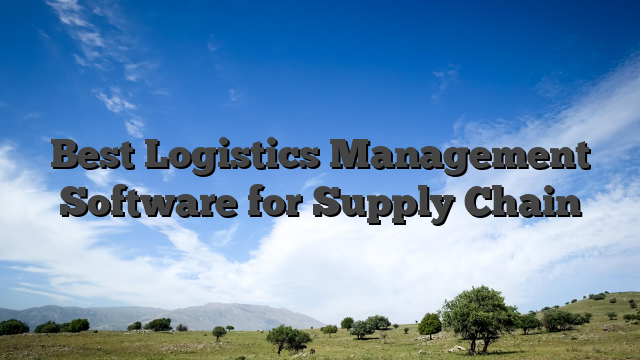Logistics management is the backbone of a well-functioning supply chain, ensuring the seamless movement of goods from production to the end consumer. In the dynamic landscape of modern business, the role of logistics management software, particularly in delivery management, has become increasingly vital. This blog explores the major components of logistics management and how delivery management software plays a pivotal role in enhancing each aspect.
Procurement and Sourcing
Procurement is the starting point of any supply chain, and effective sourcing strategies can significantly impact costs and product quality. Delivery management software streamlines this process by facilitating strategic supplier selection, efficient negotiation, and ensuring quality assurance and compliance.
Transportation and Distribution
Efficient transportation and distribution are crucial for timely deliveries. Delivery management software optimizes route planning, allows for mode selection (air, sea, land), and enhances last-mile delivery solutions, ensuring products reach their destination in the most cost-effective and timely manner.
Major Components of Logistics Management
Logistics management involves a comprehensive set of functions aimed at ensuring the smooth flow of goods and services from the point of origin to the final consumer. Understanding the major components of logistics management is crucial for businesses seeking to optimize their supply chain operations and enhance overall efficiency.
-
Procurement and Sourcing
Procurement is the initial phase of logistics management and involves the acquisition of goods, services, or raw materials from suppliers. Effective procurement strategies ensure the timely availability of quality resources, helping businesses meet production demands and maintain a competitive edge. Logistics management systems facilitate streamlined procurement processes, from supplier selection to order placement and inventory control.
-
Transportation and Distribution
Transportation is a cornerstone of logistics, encompassing the movement of goods from one location to another. This component involves choosing the appropriate mode of transportation, route planning, and optimizing delivery schedules. Logistics management software plays a crucial role in this phase by providing real-time tracking, route optimization, and analytics, contributing to cost savings and timely deliveries.
-
Warehousing and Storage
Efficient warehousing is essential for proper inventory management and order fulfillment. Warehousing involves the storage of goods, inventory tracking, and order picking and packing. Logistics management systems help optimize warehouse operations by automating inventory management, reducing errors, and ensuring that products are readily available when needed.
-
Inventory Management
Inventory management is about maintaining the right balance between supply and demand. It involves tracking stock levels, managing reorder points, and preventing stockouts or overstock situations. Logistics management systems provide visibility into inventory levels in real-time, enabling businesses to make data-driven decisions and prevent disruptions in the supply chain.
-
Order Fulfillment
Order fulfillment encompasses the entire process from receiving an order to delivering the product to the customer. This includes order processing, picking and packing, and shipping. Logistics management software streamlines these processes, automating order fulfillment tasks, reducing errors, and improving the speed at which orders are processed and shipped.
-
Information Systems and Technology
In the digital era, information systems and technology play a pivotal role in logistics management. Delivery management system integrates seamlessly with existing systems, enhancing data analytics for informed decision-making. The implementation of technologies such as the Internet of Things (IoT) and Radio-Frequency Identification (RFID) further improves supply chain visibility, allowing businesses to track and monitor shipments in real-time.
-
Reverse Logistics
Reverse logistics involves handling product returns, recycling, and disposal. Logistics management software facilitates effective reverse logistics by automating return processes, managing product exchanges, and optimizing the entire reverse supply chain. This ensures that returned products are handled efficiently, minimizing losses and maintaining customer satisfaction.
-
Risk Management
In the unpredictable world of logistics, risk management is crucial to identify and mitigate potential disruptions. Logistics management software provides real-time visibility into the supply chain, enabling businesses to identify potential risks and implement contingency plans promptly. Compliance with regulatory requirements is also streamlined through the software, reducing the likelihood of legal issues.
Delivery Management Software: Enhancing Logistics Efficiency
Delivery management software has emerged as a game-changer in the logistics industry, revolutionizing how businesses handle their supply chain operations. This technology-driven solution plays a pivotal role in enhancing overall logistics efficiency by addressing key challenges, streamlining processes, and providing real-time visibility into the entire delivery ecosystem.
- Streamlined Route Planning and Optimization
- Real-Time Tracking and Visibility
- Automated Dispatch and Scheduling
- Customer Communication and Notifications
- Proof of Delivery and E-Signatures
- Inventory Management Integration
- Data Analytics for Continuous Improvement
- Scalability and Flexibility
- Enhanced Compliance and Security
Industry Trends and Innovations in Delivery Management
A. Integration of Artificial Intelligence (AI) for Predictive Analytics
In the dynamic landscape of delivery management, Artificial Intelligence (AI) is spearheading a revolution. AI’s infusion into predictive analytics is reshaping how businesses approach deliveries. Through intricate analysis of historical data, AI algorithms forecast delivery times with unprecedented accuracy. This breakthrough optimizes routes, mitigates delays, and elevates the overall efficiency of delivery processes.
B. Blockchain in Supply Chain Visibility
The advent of blockchain technology is heralding a new era of transparency in supply chain visibility. By establishing an immutable and transparent ledger, blockchain assures the authenticity of shipment-related data. This not only fosters trust among stakeholders but also reduces the risk of fraudulent activities. The result is a secure and traceable record of every transaction within the supply chain.
C. Contactless Delivery Solutions
With the world embracing contactless interactions, delivery management software has evolved to incorporate contactless delivery solutions. These include options for contactless payments, digital proof of delivery, and real-time communication with customers. Beyond addressing safety concerns, these innovations align with the evolving preferences of consumers, contributing to a seamless and efficient delivery experience.
Tips for Successful Implementation and Adoption
A. Thorough Training for Teams
The cornerstone of successful implementation lies in comprehensive training for teams involved in the delivery process. Training programs should not merely cover the functionalities of the delivery management software but also impart best practices and protocols.
B. Continuous Monitoring and Evaluation
The journey doesn’t end with implementation; continuous monitoring and evaluation are pivotal for success. Regular assessments of key performance indicators, user feedback, and system performance empower businesses to identify areas for improvement.
C. Feedback Loops for Continuous Improvement
Establishing feedback loops is not just a strategy; it’s a culture for continuous improvement. Teams should feel encouraged to share their experiences with the software, pinpoint pain areas, and suggest improvements.
Challenges and Solutions in Implementing Delivery Management Software
A. Common Challenges Faced by Businesses
Businesses encounter common challenges during the implementation phase, such as resistance to change, data security concerns, and integration complexities. Overcoming these challenges necessitates a strategic approach, including change management initiatives, robust security measures, and seamless integration protocols.
B. Strategies to Overcome Implementation Hurdles
Strategies to overcome these hurdles involve robust training programs, early engagement of stakeholders, and leveraging the expertise of software providers. Addressing data security concerns includes implementing encryption protocols and adhering to industry standards. Choosing software solutions with flexible and scalable architecture facilitates seamless integration with existing systems.




